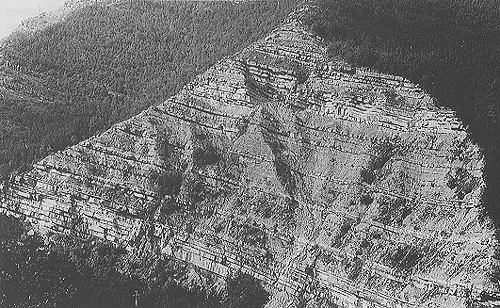
Parallel stratification: bedsets
Plate 6

Parallel stratification: bedsets
Plate 6
We are getting closer to one of the outcrops of the previous plate. Individual turbidite layers (and particularly sandstone beds) are now well recognizable when their thickness is at least 50 cm. The presence of only two rock types and their repetitiveness have convinced some geologists to qualify successions of this type as monotonous. Sedimentologists are not so happy with this term, which suggests uniformity and boredom (rhythmical is more appropriate: see plate 3). Lithologic variety is not needed to provide an interesting stratigraphy; an educated eye can read various motives in so-called monotonous successions, too. Here, for example, sandstone beds are vertically separated by a variable thickness of mudstone; some of them are isolated within the mudstone, some are grouped in packets or sets, within which there is little mudstone. As we have seen in the Introduction (see figure 10), these bedsets can be called sequences if the thickest beds are concentrated near the base, the top or the middle. Within the two bedsets visible near the summit of the cliff, no apparent sequential organization is present, while one at the base displays a thinning up trend.
What is the meaning of these packets and sequences? Do they reflect the normal functioning of the basin or an alteration of it? What is seen is a change from conditions more favorable to sand accumulation than to conditions of prevailing mud deposition. This change did not occur on a layer by layer basis but from a multilayer interval to another multilayer interval. In other words, it had not the periodicity, or time scale, of individual sedimentation events but a wider one. Apart from this change of scale, two alternative hypotheses can be set up, as done in the case of plate 3:
Sedimentologists do not know the answer yet: the two hypotheses have not been thoroughly tested, particularly by quantitative modeling (this method has been applied successfully in other branches of geology, not so in sedimentology and facies analysis). Geologists can expect, however, that the sand accumulated along basin margins in times of high sea level (when space was available in deltas, estuaries and shelves), to be remobilized and resedimented afterwards, when sea level dropped. Muddier intervals would thus reflect periods when sea level rose (transgression ) or stabilized at high stands, whereas sand sheets would coincide with low stands, when the basin margins emerged (regression ), and were subject to erosion and sliding (the two processes can be comprehensively called denudation ). Cycles of marine transgression and regression are triggered by relative sea level ups and downs in the order of a few meters up to 100-200 meters, which have various causes and time scales. It was long thought that such cycles affected sedimentation in coastal and nearshore areas only; only recently it has been realized that they leave a mark in deep water, too.
Coming back to the descriptive aspects of the outcrop, two more points are stressed: 1) The vertical variations of "sandiness" can be expressed by a sand/mud (or sandstone/mudstone) ratio, i.e., the aggregate thickness of sand versus the aggregate thickness of mud for every interval of, say, 10 layers or 10 meters (or other predefined and fixed range). This index can be plotted in a diagram to emphasize peaks and fluctuations; 2) In sand-dominated bedsets, thinner mudstone beds are intercalated; thin sand beds are similarly interbedded within mudstone dominated intervals. In general, these relatively thin units of subordinate lithology within a dominant one are called interbeds, or partings.
Marnoso-arenacea Formation, northern Apennines, Santerno valley.